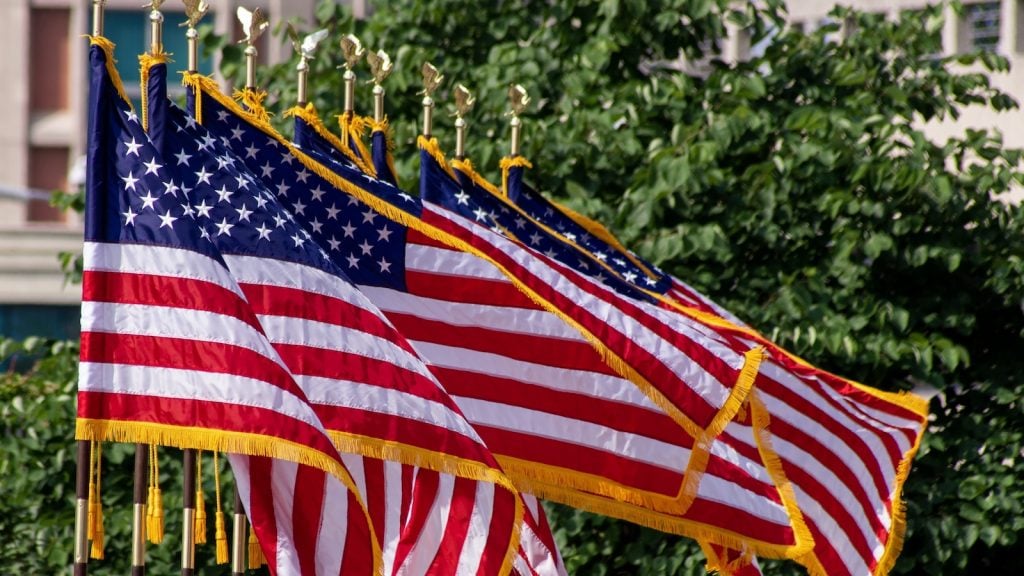What Does the Colors Red White and Blue Mean on the American Flag

Since 1777, the American Flag has been widely recognized for its red, white, and blue pattern, which is decorated with stars and stripes. This unique flag has gone by many names, including "Old Glory," "the Stars and Stripes," and "the Star-Spangled Banner."
The flag signifies an entire country, so a lot of consideration went into the flag design that we know today. Colors and patterns were selected very carefully to create a meaningful symbol for the United States.
What Do the American Flag Colors Mean?
It's thought that the American Flag's colors were inspired by Great Britain's flag, also known as the Union Jack of England. Even if this is the case, the individual colors of the American Flag each have their own meaning and significance.
The American Flag uses the colors red, white, and blue, similar to the colors of American political parties.
Red Meaning

Red stands for "hardiness and valor." It represents courage and sacrifice. Some also claim that it's related to the bloodshed of the heroes who fought to protect the freedom of America.
White Meaning

White on the flag means "purity and innocence." America is described as "pure" because they are independent of other countries and stay true to their beliefs and ideals.
Blue Meaning

Blue means "vigilance and perseverance." It's used to remind citizens to stay watchful and strong.
The colors of the pales (the vertical stripes) are those used in the flag of the United States of America; White signifies purity and innocence, Red, hardiness & valor, and Blue, the color of the Chief (the broad band above the stripes) signifies vigilance, perseverance & justice.
Charles Thompson, Secretary of Continental Congress.
By name, the official colors used on the flag are "Old Glory Blue," "Old Glory Red," and "White." These colors are for cloth standards, so the exact colors might appear differently on digital and print formats.
What Do the Stars and Stripes Mean?
Not only do the colors of the American Flag hold deeper meanings, but so do the patterns on the flag. The current flag has 50 white stars on a blue background and 13 stripes, alternating between red and white.
Stars Meaning

Each star on the flag represents a state of the union. The first version of the American Flag only had 13 stars, but ever since July 4th, 1960, it has proudly displayed 50 stars after Hawaii became the 50th state.
Stars were used for the states because they're symbols of the heavens and the divine goal.
Stripes Meaning

The American Flag has seven red stripes and six white stripes, which are all horizontal. These stripes represent the original 13 states, also known as the British Colonies.
These 13 states are represented in the stripes, based on when they became part of the union:
- Delaware – December 7th, 1787
- Pennsylvania – December 12th, 1787
- New Jersey – December 18th, 1787
- Georgia – January 2nd, 1788
- Connecticut – January 9th, 1788
- Massachusetts – February 6th, 1788
- Maryland – April 28th, 1788
- South Carolina – May 23rd, 1788
- New Hampshire – June 21st, 1788
- Virginia – June 25th, 1788
- New York – July 26th, 1788
- North Carolina – November 21st, 1789
- Rhode Island – May 29th, 1790
The colonies are shown as stripes to symbolize rays of light coming from the sun.
We take the stars from heaven, the red from our mother country, separating it by white stripes, thus showing that we have separated from her, and the white stripes shall go down to posterity representing Liberty.
George Washington
What Does the American Flag Gold Fringe Mean?

Sometimes, you might see American Flags with gold fringes along the edges. This fringe is considered "honorable enrichment only," and flags with a gold fringe can only be used permanently indoors. They could also be carried outside for certain ceremonies and events. If permanently displayed outside, the fringe will get damaged.
The fringe was first added to select flags around 1835. In 1895, it was added as a part of the flag for all regiments of the Army. Civilians aren't required to have gold fringe on their flags.
In most cases, the gold fringe is a military tradition that relates to admiralty and martial law.
History of the American Flag
The United States has gone through many changes as a country since its inception, so the flag has been adjusted several times to represent that.
It's unclear where the American Flag originated. Some historians think that New Jersey Congressman Francis Hopkinson designed it while seamstress Betsy Ross sewed the first flag. Yet, it's not confirmed.
Stars on a field of blue; one for each colony; bars of red, for the blood of sacrifice; on a ground of white for love and peace.
Betsy Ross
The American Flag became the official flag of the nation on June 14th, 1777. President Harry S. Truman later designated June 14th as "Flag Day" for that reason.
Flags can be found all over the United States as a way of showing pride for the country. Yet, there are a few locations where the flag must be up 24 hours a day, including the White House, the United States Marine Corps Memorial, and United States customs ports of entry.
Famous "Old Glory"

One well-known American Flag is named "Old Glory," which was a 10-by-17-foot flag owned by American sailor William Driver. It supposedly survived through the Civil War, despite many people trying to ruin it. When the war came to an end, Driver flew the flag over the Tennessee Statehouse.
Today, Old Glory is found at the National Museum of American History in Tennessee, still in one piece. Its name is still used as a general name for all American Flags.
Timeline of American Flag Designs

The biggest change in the American Flag has been the number of stars. From 1777 to 1960, the flag changed over 20 times to include more stars. Here is a timeline of when each star was added and for which states.
- 13 Stars (1777 to 1795)
- The original 13 states
- 15 stars (1795 to 1818)
- Vermont – March 4th, 1791
- Kentucky – June 1st, 1792
- 20 stars (1818 to 1819)
- Tennessee – June 1st, 1796
- Ohio – March 1st, 1803
- Louisiana – April 30th, 1812
- Indiana – December 11th, 1816
- Mississippi – December 10th, 1817
- 21 stars (1819 to 1820)
- Illinois – December 3rd, 1818
- 23 stars (1820 to 1822)
- Alabama – December 14th, 1819
- Maine – March 15th, 1820
- 24 stars (1822 to 1836)
- Missouri – August 10th, 1821
- 25 stars (1836 to 1837)
- Arkansas – June 15th, 1836
- 26 stars (1837 to 1845)
- Michigan – January 26th, 1837
- 27 stars (1845 to 1846)
- Florida – March 3rd, 1845
- 28 stars (1846 to 1847)
- Texas – December 29th, 1845
- 29 stars (1847 to 1848)
- Iowa – December 28th, 1846
- 30 stars (1848 to 1851)
- Wisconsin – May 29th, 1848
- 31 stars (1851 to 1858)
- California – September 9th, 1850
- 32 stars (1858 to 1859)
- Minnesota – May 11th, 1858
- 33 stars (1859 to 1861)
- Oregon – February 14th, 1859
- 34 stars (1861 to 1863)
- Kansas – January 29th, 1861
- 35 stars (1863 to 1865)
- West Virginia – June 20th, 1863
- 36 stars (1865 to 1867)
- Nevada – October 31st, 1864
- 37 stars (1867 to 1877)
- Nebraska – March 1st, 1867
- 38 stars (1877 to 1890)
- Colorado – August 1st, 1876
- 43 stars (1890 to 1891)
- North Dakota – November 2nd, 1889
- South Dakota – November 2nd, 1889
- Montana – November 8th, 1889
- Washington – November 11th, 1889
- Idaho – July 3rd, 1890
- 44 stars (1891 to 1896)
- Wyoming – July 10th, 1890
- 45 stars (1896 to 1908)
- Utah – January 4th, 1896
- 46 stars (1908 to 1912)
- Oklahoma – November 16th, 1907
- 48 stars (1912 to 1959)
- New Mexico – January 6th, 1912
- Arizona – February 14th, 1912
- 49 stars (1959 to 1960)
- Alaska – January 3rd, 1959
- 50 stars (1960 to present)
- Hawaii – August 21st, 1959
Throughout all these years, the colors and symbols of the American Flag remained the same. It still represented valor, purity, and perseverance, due to its consistent colors.
Color Meanings in Flags

As it turns out, the color meanings for flags are fairly universal. Most flags use only a few colors, and many of them share colors schemes. While some flags are an exception, here's the general symbolism for flag colors.
Black
Black in flags often represents determination or ethnic heritage. In some cases, it has darker meanings, such as death, morning, and the defeat of enemies.
White
Like in the American Flag, white symbolizes purity, peace, and harmony. However, a solid white flag is sometimes used to signify surrender during a battle.
Red
Red has a wide range of meanings, including power, war, revolution, courage, domination, and vibrancy. If it's related to war, then the red symbolizes bloodshed. Red flags are sometimes used to signify danger too.
Blue
Blue tends to mean different things depending on which flag you are referring to. Some meanings include determination, alertness, liberation, and good fortune.
Green
Green is a color that's commonly seen in nature, so flags with green have some association with agriculture, prosperity, and fertility. In some cases, green flags are also related to youth and hope.
Yellow
This color is often associated with the sun and money, so it means wealth or energy. In some cases, it could also mean happiness. If gold is used on a flag instead of yellow, it often shares the same meanings.
Orange
Orange isn't used as often as the other colors, but it usually means courage and sacrifice.
Flags symbolize different countries, and they're often thought very highly of, so it makes sense that their designs would have deeper meanings. The American Flag is one of the flags with the most notable meanings, and it has greatly evolved over time.
Source: https://www.color-meanings.com/what-do-the-american-flag-colors-mean/
0 Response to "What Does the Colors Red White and Blue Mean on the American Flag"
Enregistrer un commentaire